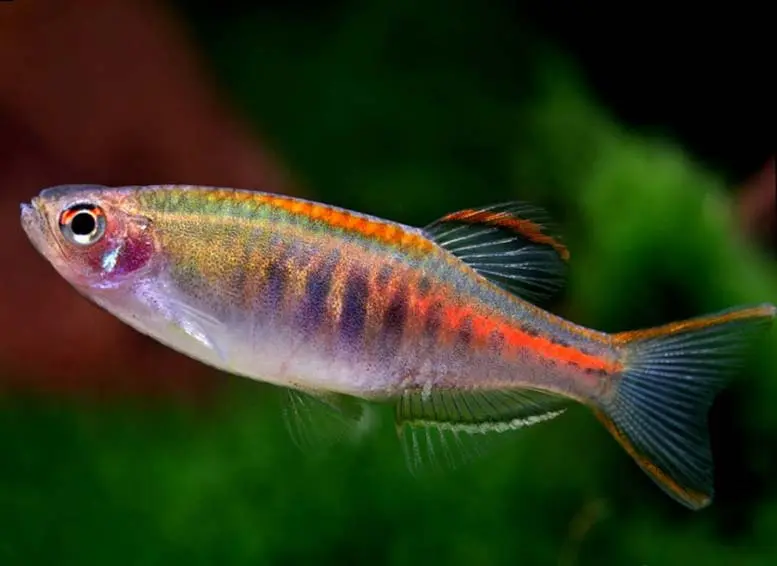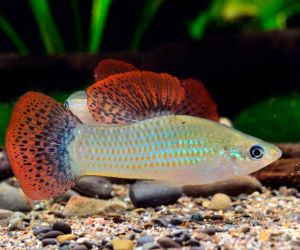
Danio Hopra
Danio choprae, scientific name Danio choprae, belongs to the Cyprinidae family. One of the most beautiful aquarium fish due to its rich palette of colors, a flock of such small fish can decorate any aquarium, also known as the Luminous Danio. This species is no less hardy than other Danios, which makes it an optimal acquisition for any aquarist.

Deliveries to the European and American markets began only in 2003, the first batches were fish caught in the wild. Currently, programs are being implemented for their mass breeding in captivity.
Requirements and conditions:
- The volume of the aquarium – from 40 liters.
- Temperature – 23-27°C
- Value pH — 6.0–7.0
- Water hardness – soft to medium hard (5-15 GH)
- Substrate type – any dark
- Lighting – subdued, moderate in the presence of floating plants
- Brackish water – no
- Water movement – moderate
- Size – up to 3 cm.
- Meals – any
- Life expectancy – up to 5 years
Habitat
Danio Khopra was first described in 1928 and named after Dr. Chopra (Khopra), who collected the first specimens. In the wild, it is found exclusively in the Irrawaddy River in the northern part of Myanmar (Burma), in Southeast Asia. They live in small rocky streams with a gravel substrate, in clear water rich in oxygen.
Description

A slender bright fish, the smallest among Danios, body dimensions do not exceed 3 cm. The color of the body has several shades at the same time: red, turquoise, yellow, orange, green, blue, blue. A kind of rainbow fish.
Food
The fish are omnivorous species, in the aquarium they will gladly accept high-quality dry food. Since the Danio leads an active lifestyle and has high nutrient requirements, choose foods rich in micronutrients and organic matter.
Maintenance and care
Danio Khopra does not require special conditions of detention. Enough clean clear water and its weekly renewal by 25-30%. A powerful filter will provide not only water purification, but also create an imitation of the flow of river waters. Sufficient enrichment of water with oxygen can be achieved by placing several atomizers in the aquarium that create small bubbles. The lighting is subdued, similar to their habitat. From bright light, the color of the fish becomes faded. In the design, preference should be given to plants with wide leaves that reach the surface of the water, as well as floating plants that will provide additional shading. A dark soil substrate is able to emphasize the bright colors of the fish; against a contrasting background, they look more impressive.
Social behavior
Peaceful schooling fish, prefers neighborhood with its own kind. It is recommended to keep at least 10 individuals in a flock, they lead an active lifestyle, chasing each other, but this is part of the game, not aggression. If there are few fish, then Danio becomes lethargic, refuses to eat and becomes susceptible to disease.
The fish are rather shy, so if there is even a peaceful and slow, but large fish in the aquarium with them, they will seek to hide, perhaps they will try to jump out of the aquarium. Joint keeping is allowed only with the same small peaceful fish.
Breeding / breeding
With the joint maintenance of males and females, males become brighter, more significant sexual differences are not observed. For breeding, you should use a separate tank, since it will require special conditions to be established in it, and this will also save the eggs from being eaten.
A spawning aquarium of 10 liters is more than sufficient, the design should consist of a dark substrate (large gravel is desirable), low plants with small leaves, snags, grottoes made of stones, and so on. The lighting is dim, enough light from the room where the aquarium stands. The composition of the water is identical to the main aquarium. The eggs, falling to the bottom, are lost among the plants and gravel, there is a chance not to be eaten by their parents, who are not averse to feasting on them.
In favorable conditions and with good feeding, adults form pairs and begin mating dances. Two fish are circling with each other, one of them has a large inflated belly – this is a female with caviar. The couple should be caught and placed in a separate prepared aquarium, where the female will begin to spawn. About 50 eggs will be released, which are then fertilized by the male. Fry appear in 3-4 days, feed with microfeed. After half a year, they become large enough to be placed in a community aquarium.
More about breeding Danio
Diseases
Danio are resistant to diseases, provided they are properly kept and there is no contact with infected fish. Read more about symptoms and treatments in the Aquarium Fish Diseases section.
Features
- small fish sizes
- Flock keeping at least 10 individuals
- Not allowed to be kept with large fish





